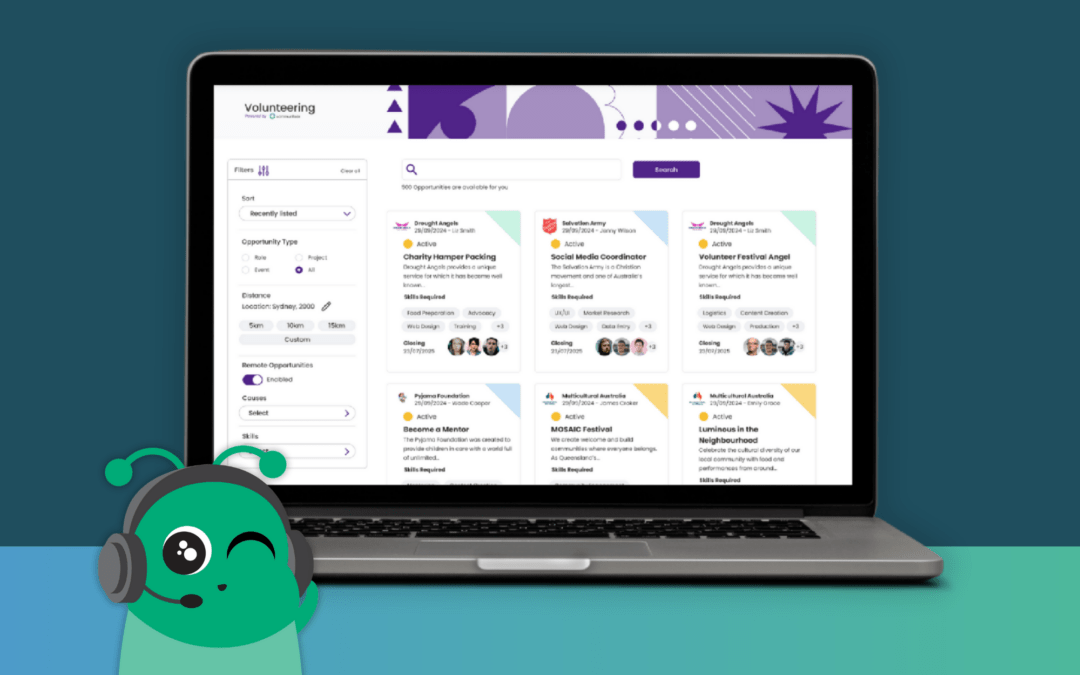Many companies now offer corporate volunteer leave as a perk, but even the best-intentioned programs can face challenges when employees aren’t fully aware of their entitlements or struggle to find time to use them.
According to Volunteering Australia’s latest Corporate Volunteering Snapshot, at least 78% of companies have a volunteering program, with over half planning to boost participation levels.
In 2018, only 15% of employees engaged in volunteering, reflecting a 3.7% increase from 2006.
The snapshot revealed that although corporate volunteers contributed over one million hours to the community in 2018, there was an additional 500 full-time equivalent (FTE) hours of corporate volunteering capacity that remained untapped.
If you are overseeing a corporate volunteering program, here’s how you can help employees become aware of and make the most of their leave entitlements.
1. Start with Clear Communication and Education
Your employees can’t use what they don’t know about. One of the most important steps in promoting employee volunteer leave is to ensure your team is aware of it.
Integrate information about volunteer leave into onboarding sessions, employee handbooks, and your company intranet. Consider sending out regular reminders via newsletters or email, especially during key volunteering seasons.
Providing easy-to-access resources, such as FAQs or how-to guides, can empower employees to quickly find the information they need.
2. Engage HR and Leadership to Spread the Word
Your HR team and department leaders are key allies. Equip them with the knowledge and tools they need to encourage paid volunteer leave usage.
Conduct training sessions to help line managers communicate volunteer leave benefits effectively and proactively engage employees who may be interested.
By having personalised conversations, leaders can align volunteering opportunities with each employee’s interests and professional development plans.
“Connections and experiences are priceless, and that is what this volunteering journey has truly exemplified for me. And I believe, there’s more for me to learn and share.”
Mohandeep Singh, Student Volunteer with UTS
3. Simplify the Corporate Volunteer Leave Request Process
One of the main barriers to using leave is a complicated or unclear process. Make applying for volunteer leave as seamless as possible.
Consider using a streamlined digital form or integrating leave requests into your existing HR software. Make sure the process is straightforward, with clear instructions on how to apply, what activities qualify, and how much time employees can take.
Offering an easy way for employees to check their available volunteer leave policy and balance can also encourage more participation.
4. Recognise and Reward Volunteer Efforts
Everyone loves to be appreciated! Recognise employees who take leave and make a positive impact, whether it’s through a shout-out in your internal newsletter, during team meetings, or with a spot in a “Volunteer of the Month” feature.
You could also host challenges, where departments compete to see who can log the most volunteer hours, fostering both team spirit and community engagement.
“It was a collaborative effort with real outcomes to real problems. I found the experience immensely rewarding, educational, and ultimately meaningful as I felt my time was well utilised and I felt collectively we made a real impact on a real medical challenge.”
Koray Koksa, Corporate Volunteer from Pfizer
5. Align Volunteering with Company Goals and Events
To truly embed a culture of volunteering, tie volunteer leave opportunities to your company’s corporate social responsibility (CSR) initiatives.
Whether it’s supporting local communities, sustainability projects, or education, connecting these goals with volunteer leave makes it clear how individual contributions ladder up to something bigger.
Encourage employees to plan their volunteering around company-wide volunteer days or special events, ensuring they take advantage of their leave during key times of the year.
6. Consider Other Corporate Volunteering Structures, such as Skilled Volunteering
Skilled volunteering, when broken down into manageable hours over a few weeks, offers a flexible alternative to full-day or half-day commitments for employee volunteering.
By spreading the volunteer work across several weeks, employees can integrate their volunteering efforts with their regular responsibilities, reducing the strain of taking extended time off.
“The flexibility that allows for volunteering within the working day is just awesome. This is I think a better way of using some of that leave, an hour a week over a period of time. Having that in the calendar, I get to draw myself out of the day-to-day to work on someone else’s challenges or concerns.”
Dan Uhlmann, Corporate Volunteer from Roche
To wrap up!
Your role as manager of your company’s corporate volunteering program is pivotal in helping employees take full advantage of leave.
By promoting awareness, simplifying processes, and fostering a culture of recognition and alignment with company values, you can ensure that volunteer leave becomes a celebrated and widely used benefit.
Ultimately, when employees are encouraged and supported to give back, everyone benefits – your team, your company, and the community.
See how Communiteer can support your corporate volunteering program here!




